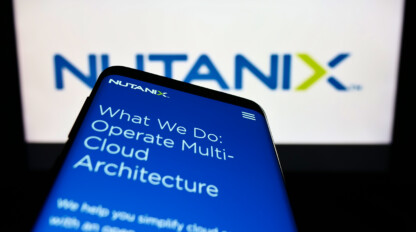What is Cloud Migration? Process, Strategies and Helpful Tips

Enterprises around the globe are looking to migrate their infrastructure to the cloud. According to G2, over a third of companies (33.4%) will migrate from legacy enterprise software to cloud-based tools in 2023. Economic uncertainty shows no trends in this phenomenon slowing down, mand it’s important for businesses to consider various factors before jumping into the process themselves. Whether your business is looking to move an individual workload or your entire environment, cloud migration requires careful planning.
However, when moving to a cloud environment, many organizations make little effort to make sure that their environment is cloud optimized. Walking into a cloud migration without careful planning can result in costly infrastructure problems, potential outages and more. Every component in the cloud works hand in hand. From billing to machine learning to programming to security, it’s beneficial in many ways to adopt to the cloud platform – but it needs to be carefully handled.
What is cloud migration?
Cloud migration involves moving an organization’s digital assets, including servers, databases, applications and IT resources to the cloud. This migration can take place from an on-premise infrastructure fully to the cloud, partially to the cloud or from one cloud to another. Whatever the capacity of your cloud migration is, it’s crucial to have a personalized, thorough migration plan before getting started.
What are the benefits of cloud migration?
Migrating to the cloud empowers businesses to boost flexibility, scalability and productivity.
Make sure that you have a deep understanding of all the features for each type. Public, private and hybrid cloud all provide similar benefits, but you should choose the best deployment method for your business.
Performance & Reliability
To optimize your cloud computing, make sure you have full transparency before making the jump. Reliability is a major factor to consider. Once configured correctly, it could make managing your environment a lot easier — and in some cases, cheaper.
Performance is also key in a healthy cloud environment. Most organizations migrate workloads to the cloud to improve their operational performance. Having the right resources or the most patched software can indicate how the environment can handle stressful situations.
Cost
Cloud adoption doesn’t necessarily have to be a costly venture, as the leading cloud providers are continuing to evolve their offerings. There are many factors to consider when budgeting for cloud-based platforms and calculating the total cost of ownership. Some potential costs when executing a cloud migration plan include:
- Hardware and Software Costs:servers, software licenses, warranties, current consumption and storage capacity, etc.
- Operational Costs: labor and talent; facilities; administrative requirements to maintain, hire or retrain your IT department
- Indirect Costs:downtime or productivity loss if your IT infrastructure were to go down
- Execution Costs: the costs involved from moving IT operations and data to the cloud; application integration and testing; third-party consultant fees
- Post-migration Costs: monthly infrastructure; fees involved in maintenance and improvements for the new environment; continued integration and app testing, training, security and compliance
When everything is all said and done, it’s very likely that these costs will amount to a smaller number than what you are currently paying for your on-premise infrastructure.
What are some common challenges of cloud migration?
Security
Security is a significant worry when adopting a new cloud computing strategy. One of the biggest concerns for any business when it comes to cloud migration is the fear of data loss. It’s important that you have the right partner who will make sure your concerns are addressed and that your information is secure. ivision’s cloud solutions go through rigorous testing and give your business protection for your most sensitive data.
There is a lot of work that goes into safeguarding infrastructure, and ignoring this effort can lead to other difficulties down the road. Migrating to and from any cloud infrastructure is bound to pose some security risks. It’s critical that you are prepared for any hitch.
Lack of Strategy
Undergoing cloud migration requires thorough attention to detail and extreme foresight. It’s important that business don’t jump into the process blindly without doing their due diligence, understanding the motivation behind the migration and devoting sufficient time and attention to their strategy. Businesses can often overlook the different requirement and considerations of each application and dataset, neglecting the fact that it may need its own unique approach. By establishing a clear business case for each workload and committing to end-to-end cloud migration planning, businesses can save themselves, their vendors and their end users a whole lot of headache and money.
Vendor Lock-In
Once you’ve committed to a vendor for your cloud journey, it can be difficult to leverage the services of other providers who may be able to help you succeed in a different area. This is a common issue for early adopters of cloud technology. Migrating from one cloud to another can be a challenging, costly production, so understanding what you’re getting into when choosing your cloud provider from the get-go can help alleviate this need. By doing your research on cloud providers and matching up their services with your needs, your business is in a much better position to succeed in the long run.
Are there different cloud migration strategies to choose from?
There are a handful of different cloud migration strategies depending on the capacity and end goal of your migration. These strategies were initially labeled “The 5 Rs” by Gartner, but have since expanded to “The 7 Rs”: refactor, replatform, repurchase, rehost, relocate, retain and retire.
Refactor
Refactoring, or re-architecting, your application includes leveraging cloud-native features to enhance agility, performance and scalability while conforming to enterprise standards, functional needs and security needs.
Replatform
Also known as the “lift and reshape” method, replatforming transitions the application to the cloud while optimizing to reduce the total count of enterprise supported platforms. This helps reduce operational expense.
Repurchase
Repurchasing, or “drop and shop,” involves transitioning to an entirely new product, typically by adopting a SaaS model.
Rehost
The rehost, or “lift and shift” method, transfers an application from an on-premise host to a cloud platform without optimization.
Relocate
Relocating, also known as “hypervisor-level lift-and-shift” allows you to shift infrastructure to the cloud without needing new hardware, application rewrites or adjusting your current operations.
Retain
Retaining applications means keeping them in their current environment and revisiting them at a later date to see if migration is worth the cost and effort.
Retire
Rather than undergoing the migration process, some applications have already served their purpose and are able to be laid to rest. Identifying and retiring these applications early helps your business save time, money and energy by reducing your migration load.
What does the cloud migration process look like?
When building your cloud migration strategy, you want to determine the best way to do it in terms of efficiency, flexibility, cost effectiveness and most importantly, long-term successful.
Define goals and objectives.
Why is the migration path necessary or being explored? Is this for scale, cost or security purposes? Having an end goal in mind before starting the process is key in your success and future optimization efforts.
Review current configurations.
Before you can start your migration, it would be best to understand the environment you are currently working in. Assess its flaws, its opportunities and what you ultimately want to gain with this new configuration.
Determine your cloud provider.
Each provider has benefits that can be helpful to your migration. It’s best to align the needs of your business (size, budget, end users, etc.) to the platform you will migrate to.
Develop a migration plan.
Will this be a hybrid environment, or will everything be placed on the cloud? Will you consider multi-cloud as well? Before you can make this decision, it’s important to understand the basics. There are three different ways to deploy cloud resources: public, hybrid or private cloud.
Public Cloud:
- Owned and operated by a third-party cloud service provider
- You share the same hardware, storage and network devices with other organizations
- Usually a pay-per-usage billing model that can save a significant amount of money
- Highly reliable with almost unlimited scalability
Private Cloud:
- Provides a dedicated IT infrastructure on your own private network
- More flexibility to customize the environment to meet specific business needs
- Improved security because your resources are not shared
- Still have the scalability and reliability of public clouds
Hybrid Cloud:
- Data and applications can move between public and private clouds
- Ability to maintain a private infrastructure for more sensitive operations
- Cost-effective, but allows you to scale to additional public cloud resources when needed
- Easier transition to the cloud because you can gradually migrate
Begin to test and validate.
Before rolling out your strategy, you should first test that it works in a sample environment before moving to production. This can help avoid any potential risks or failures during the actual migration.
Monitor your test environment.
This will allow you to determine if any issues or concerns have come up post migration and address them early.
Optimize your migration.
By optimizing your migration, you will find ways to reduce latency, increase performance and reduce overall cost.
Learn how ivision can help with your cloud migration
Migrating to a cloud environment may seem like a hassle, but it will bring many other benefits. It will allow your business to be more agile and flexible. You can quickly scale in an instant. You will be able to sleep easier at night knowing that your cloud environment has high availability, backup and recovery.
Working with a trusted IT services partner, like ivision, can take away much of the stress that comes with cloud migrations. Furthermore, once you have deployed a solution, a reputable managed services provider can ensure seamless coverage on your cloud environment, helping you:
Optimize resources through day-to-day management so that your internal team can focus on business drivers.
Secure your data with disaster recovery solutions to protect you from downtime.
Manage vendors and help track hardware, software and manufacturer contracts.
Each component makes all the difference in the long run for a successful cloud migration. Every change matters — the moment you set foot in the cloud.
ivision has extensive experience helping clients succeed in cloud migration. Whether you’re looking to deploy public, private or hybrid cloud, our certified cloud engineers can help optimize your environment and take the headache out of cloud migration. We partner with industry leaders, like Amazon and Microsoft, to offer expertise in AWS, Azure and M365. Contact us to get started today!



